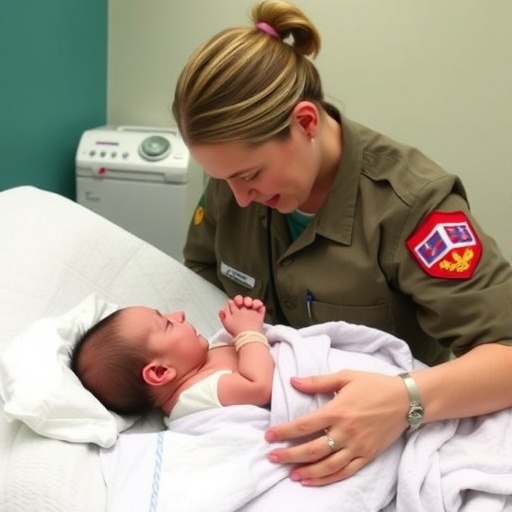In an unprecedented retrospective study conducted in the region of Styria, Austria, researchers have unveiled critical insights into the complexities faced by emergency medical teams during unplanned out-of-hospital births, particularly those involving premature infants. Although such deliveries comprise a small fraction of overall births, their unpredictability and the fragile condition of many newborns present significant challenges to paramedics and emergency responders tasked with providing immediate care in uncontrolled environments.
From 2017 to 2024, a total of 173 unplanned home or out-of-hospital deliveries were documented, with premature births—defined as those occurring before 37 weeks of gestation—accounting for approximately 9%. The most extreme case involved an infant born at just 26 weeks, weighing a mere 845 grams, emphasizing the precarious nature of these situations. Alarmingly, the mortality rate was high, with one-quarter of preterm infants succumbing shortly after birth, underscoring the urgency of improving pre-hospital neonatal care protocols.
This study sheds light on an often-overlooked aspect of emergency care: the adequacy of preparation, equipment, and training for medical personnel when confronted with rare but high-stakes events such as premature deliveries in non-hospital settings. The involvement of specialized neonatal transport teams and adherence to standardized emergency procedures are identified as critical factors that could mitigate morbidity and mortality.
One of the pivotal discoveries of the investigation was the variable approach to neonatal resuscitation and stabilization. Among the infants who did not survive, resuscitation attempts were absent in half the cases, highlighting a potential gap in emergency protocols or situational decision-making under duress. Conversely, successful pre-hospital intubation and ventilation in some instances demonstrate the life-saving potential of advanced neonatal interventions when appropriately executed.
Temperature regulation emerged as a vital prognostic facet frequently overlooked in initial emergency management. Of the premature infants admitted to hospitals, only a fraction had their admission temperatures recorded, with many presenting hypothermia, a condition known to exacerbate neonatal complications. Given that thermal instability can precipitate respiratory and metabolic distress, its management is now recognized as an essential component of neonatal emergency protocols.
The report emphasized the current limitations of emergency teams’ pediatric expertise. While most emergency physicians excel in adult care, fewer possess specialized training in neonatology. Recognizing this shortfall, the study advocates for regular, targeted training sessions focusing on neonatal emergencies and incorporation of paediatric-specific equipment into all emergency vehicles to ensure readiness for similar incidents.
Helena Leonhartsberger, a dual-trained paramedic and medical student specializing in neonatology, spearheaded the research after firsthand exposure to an out-of-hospital birth during her early paramedic training. Her experience catalyzed a deeper inquiry into how such critical events are managed and how systemic improvements can be instituted to better prepare emergency responders for the unpredictable landscape of premature labor outside hospital settings.
The research team, led by Professor Bernhard Schwaberger of the Medical University of Graz, meticulously analyzed factors such as gestational age, newborn weight, survival rates, and interventions performed in the pre-hospital setting. The median gestational age at birth was 35 weeks with a corresponding median birth weight of approximately 2390 grams, illuminating the spectrum of prematurity and the diverse care requirements these neonates necessitate immediately after birth.
Importantly, the study identifies a significant gap in documentation practices, particularly regarding vital signs and thermoregulation in neonates transported to hospitals. The median recorded temperature was below the normal physiological range, and temperatures as low as 31.5°C were noted—temperatures that fall markedly below the threshold for effective neonatal resuscitation and require urgent corrective measures.
Experts outside the study have underscored the global relevance of these findings. Dr. Felix Lorang, an emergency medicine specialist from Germany, highlighted that premature deliveries in uncontrolled environments require adherence to “High-Acuity Low Occurrence” (HALO) procedures. These protocols are vital for ensuring emergency teams are equipped not only with the correct technical skills but also with the necessary logistical support to manage infants born in unpredictable circumstances.
The broader implications of this research extend beyond the borders of Austria. Plans are underway to expand the geographic scope of data collection to identify differences in regional preparedness and practices, which could ultimately inform international standards. The integration of neonatal-specific equipment, such as portable incubators and advanced airway management tools, alongside comprehensive training programs, may be instrumental in reducing adverse outcomes in preterm out-of-hospital births worldwide.
Moreover, the study calls attention to public education on the risks associated with unplanned home births. While planned home deliveries can be safe under stringent conditions with professional oversight, unexpected or premature labor can rapidly devolve into emergency scenarios. Amplifying awareness among expectant mothers and families about the signs of premature labor and the importance of emergency preparedness may serve as a crucial adjunct to medical interventions.
In conclusion, this groundbreaking study presents a compelling case for systemic enhancements in the pre-hospital care of premature infants born unexpectedly outside a hospital setting. Through standardized protocols, continual medical education, and the deployment of specialized equipment, emergency medical services can better navigate the demanding scenarios posed by these births. The ultimate goal remains unwavering: to safeguard the health and survival of both mothers and their most vulnerable newborns, regardless of where delivery occurs.
Subject of Research: People
Article Title: Pre-hospital emergency care for preterm infants after unplanned out-of-hospital deliveries: a retrospective case series from Styria, Austria (2017–2024)
News Publication Date: 29-Sep-2025
References:
[1] Abstract no: OA122, “Pre-hospital emergency care for preterm infants after unplanned out-of-hospital deliveries: a retrospective case series from Styria, Austria (2017–2024)” by Helena Leonhartsberger, Pre-hospital session, Monday 29 September, 11:00-12:30 hrs CEST, Schubert 4 room
Image Credits: Helena Leonhartsberger
Keywords:
Premature birth, Obstetrics, Emergency medicine, Health care delivery, Home care, Emergency rooms, Hospitals, Midwifery, Prenatal care, Postnatal care, Miscarriage, Pregnancy complications
Tags: emergency care preparationemergency medical responsehigh-stakes medical emergenciesmaternal and infant health risksneonatal care protocolsneonatal transport teamsparamedic training for childbirthpremature birth challengespreterm infant mortalityStyria Austria studyuncontrolled birth environmentsunplanned out-of-hospital births





